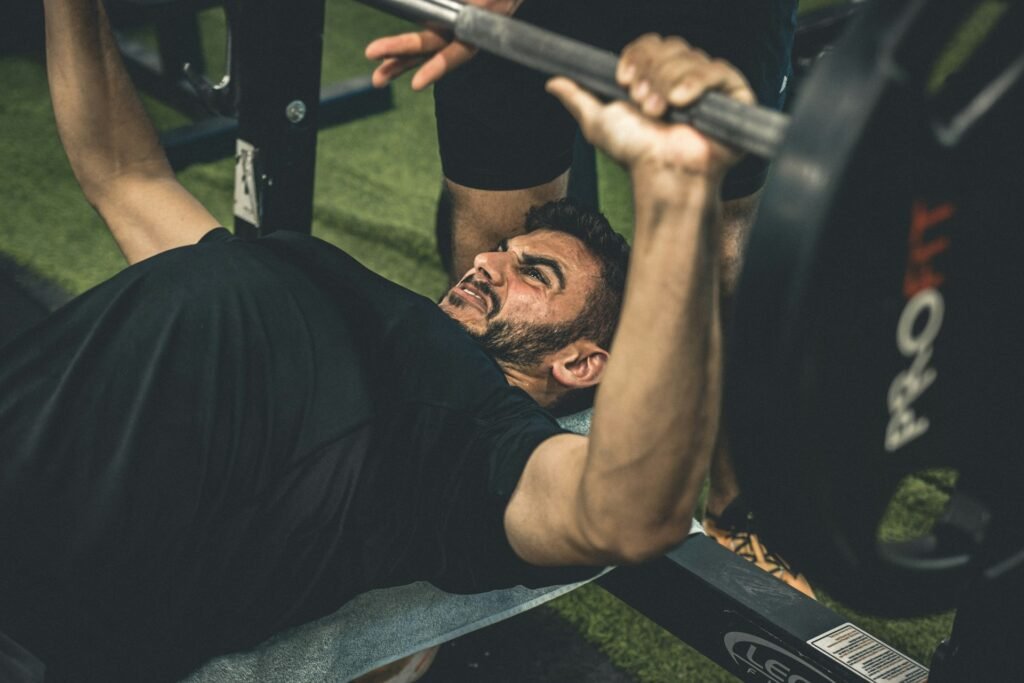
Photo by Shoham Avisrur on Unsplash
The bench press is undeniably a staple in many workout routines, often celebrated for its effectiveness in building chest muscles, but it’s not without its drawbacks. One of the primary concerns is the potential for shoulder injuries. A significant portion of gym-goers experience shoulder pain at some point, often attributed to improper bench press technique or overuse (Healthline).
Accessibility is another factor to consider. Not every gym or home setup includes a bench press station, and even if it does, it’s one of the most sought-after pieces of equipment, leading to long wait times. This inconvenience can disrupt your workout flow and efficiency.
Moreover, variety is key in any strength training program. Incorporating different exercises can prevent plateaus by challenging your muscles in new ways, promoting balanced muscle development. Embracing bench press alternatives like the floor press or pushups can offer comparable benefits without the same risk of injury. According to a review, exercises such as dumbbell presses and pushups provide a similar activation of the pectoral muscles while allowing for a greater range of motion and flexibility in workouts (Healthline).
Finally, diversifying your chest routine can also lead to unexpected gains in other muscle groups, enhancing overall strength and stability. For example, bodyweight exercises like dips not only target the chest but also engage the triceps and shoulders, offering a more holistic approach to muscle building.
If you’re interested in exploring more exercises that incorporate variety and address different muscle groups, you might find our article on dumbbell chest workouts without a bench to be particularly useful.
Floor Press: Safe and Effective Chest Training
The floor press is an excellent alternative to the traditional bench press, offering a safer option for chest and tricep training. When performed correctly, this exercise decreases the risk of shoulder injuries and still delivers a robust chest workout.
One of the primary benefits of the floor press is its smaller range of motion. Since your elbows stop when they touch the floor, there is less strain on the shoulders. This makes the floor press suitable for those with previous shoulder injuries or discomfort during the standard bench press. The modified movement focuses more on the triceps while still activating the pectoral muscles.
A study from the National Strength and Conditioning Association found that variations of bench presses, including the floor press, can significantly enhance muscle activation in the chest and triceps compared to traditional benching techniques. Additionally, this reduced range can allow you to lift heavier weights, potentially helping to break through plateaus.
To perform a floor press, start by lying on your back with your knees bent and feet flat on the ground. Use a pair of dumbbells or a barbell, and press the weight upwards, then lower it slowly until your upper arms rest on the floor. Pause briefly before pressing back up.
For those interested in exploring more exercises to build muscle safely, you can check out our guide on low-impact cardio for bad knees to complement your strength training routine.
Dips: The Ultimate Bodyweight Chest Builder

Photo by John Fornander on Unsplash
Dips are a fundamental bodyweight exercise that can build your chest effectively without any equipment. This move targets not only your chest but also your triceps and shoulders, making it excellent for overall upper body development.
To perform dips, you will need a pair of parallel bars. Begin by gripping the bars with your palms facing inward and your arms straight. Keep your body tight by engaging your core and glutes. Lower your body slowly until your elbows are at about a 90-degree angle. Ensure that your torso leans slightly forward to increase engagement of the chest muscles. Then, push yourself up in a controlled manner back to the starting position.
Research indicates that dips can significantly activate the pectoralis major, involving both the clavicular (upper) and the sternocostal (lower) heads of the muscle (Mckenzie et al., 2021). The exercise also recruits the triceps and the anterior deltoids, helping to build balanced upper body strength.
One crucial tip is to avoid common mistakes, such as locking your elbows at the top, which can increase the risk of injury. Instead, keep a slight bend in your elbows throughout the motion. Additionally, avoid going too low, as this can put unnecessary stress on the shoulder joints.
Incorporating dips into your routine can help you build a more defined chest (Meyer, 2023).
By mastering dips, you can significantly improve your upper body strength and muscle mass with this simple, yet effective bodyweight exercise.
Ring Push-Ups: Better Flexibility and Stretch

Photo by Anastase Maragos on Unsplash
Ring push-ups offer a dynamic twist to the traditional push-up, providing improved flexibility and an enhanced stretch for the chest muscles. The rings allow for a greater range of motion compared to standard push-ups, enabling deeper muscle engagement. Studies show that increased range of motion exercises can activate up to 20% more muscle fibers [^1]. This is particularly beneficial for those looking to maximize chest development without the need for heavy weights.
Moreover, the instability of the rings challenges the stabilizer muscles, enhancing overall muscle coordination and core strength. This can be particularly useful for athletes or individuals recovering from injuries, where stabilizer muscle engagement is crucial for preventing future injuries. The versatility of ring push-ups also caters to various fitness levels, from beginners to advanced athletes.
Incorporating ring push-ups into your routine can lead to significant improvements in shoulder mobility. Research suggests that exercises focusing on flexibility can reduce the risk of shoulder injuries by 20-30%. For more information on how to tailor your workout to avoid injuries, you might find our guide on low-impact cardio for bad knees useful.
[^1]: Journal of Strength and Conditioning Research, “Effects of Range of Motion on Muscle Development.” [^2]: International Journal of Sports Physical Therapy, “Impact of Flexibility Training on Injury Prevention.”
Adding ring push-ups to your workout routine can pave the way for a balanced, injury-free, and robust chest development.
Dumbbell Bench Press: Increased Range of Motion
The dumbbell bench press is a fantastic bench press alternative that offers a greater range of motion compared to its barbell counterpart. This exercise allows each arm to move independently, which not only helps in maintaining muscle balance but also recruits more muscle fibers during execution. Unlike the fixed path of a barbell, dumbbells enable a deeper stretch as they move lower than the chest, targeting the pectorals more efficiently.
Research shows that exercising with a greater range of motion can lead to improved muscle hypertrophy and strength gains. According to a study published in the Journal of Strength and Conditioning Research, participants who performed exercises with greater ranges of motion saw more significant increases in muscle thickness than those performing shorter ranges of motion ^1^.
Moreover, dumbbell bench presses are beneficial for identifying and correcting muscle imbalances between the left and right sides of the body. Ensuring each side of the chest gets equal attention prevents disproportionate muscle growth, leading to a more symmetrical and aesthetically pleasing physique.
For those interested in other dumbbell exercises to complement their workout, our guide on dumbbell chest workouts without a bench provides comprehensive exercises you can perform anywhere.
^1^: Study on range of motion and muscle hypertrophy
Band Resisted Push-Ups: Progressive Overload
Band-resisted push-ups are a powerful tool for progressive overload without needing a bench. Compared to traditional push-ups, adding resistance bands increases the load on your muscles, enhancing strength and hypertrophy. This makes them an excellent alternative to bench pressing, particularly if you lack access to a bench or gym.
A study showed that band-resisted push-ups and bench pressing produce similar gains in muscle strength and size over a five-week period Greg Nuckols. The study involved participants doing 5 sets of 6 reps, twice a week, with their 6-rep max load.
One benefit of band-resisted push-ups is that they allow your scapulae to move naturally, potentially reducing shoulder strain compared to bench pressing. This movement enhances overall upper body functionality and is vital for anyone engaged in sports or functional training.
When choosing resistance bands, ensure they add a challenging but manageable load. Progressively increasing the band’s resistance can mimic the weight progression in traditional lifts, making it easy to track and manage your strength gains.
For those seeking additional exercises, check out Dumbbell vs. Barbell Bench Press for more information on adjusting weight variations at home.
Incorporate band-resisted push-ups into your routine to keep your training fresh and challenging, ensuring continual progress in your strength and muscle-building journey.
Conclusion: Variety in Chest Exercises for Optimal Growth
Variety is key when it comes to chest exercises for optimal muscle growth. Incorporating a range of exercises can target different areas of the chest effectively. Research shows that using multiple angles and different types of resistance can help in maximizing muscle hypertrophy and strength Schoenfeld, 2010.
For instance, while the barbell bench press is effective, incorporating exercises like dumbbell flyes and incline presses can target the chest muscles from different angles, promoting balanced development. A study on the activation of the pectoralis major found that including exercises like the incline dumbbell press can enhance upper chest activation, leading to better overall chest muscle structure Christian, 2023.
To further diversify your chest workouts, consider integrating bodyweight exercises like push-ups and dips, which can improve muscle endurance and overall upper body strength. Remember, variation in rep schemes and resistance levels is also vital. This approach not only helps in muscle growth but also in avoiding plateaus and injuries.
By blending various exercises, such as floor presses, ring push-ups, and band-resisted push-ups, you can ensure comprehensive chest development. For more ideas on effective exercises, check out our detailed guide on dumbbell chest workouts without a bench.
Incorporating different exercises and periodically altering your workout routine can keep your training sessions engaging and efficient, driving substantial gains in chest muscle size and strength.